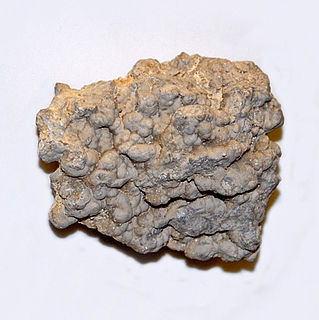
The Permian–Triassic extinction event, also known as the P–Tr extinction, the P–T extinction, the End-Permian Extinction, and colloquially as the Great Dying, formed the boundary between the Permian and Triassic geologic periods, as well as between the Paleozoic and Mesozoic eras, approximately 251.9 million years ago. It is the Earth's most severe known extinction event, with around 81% of all marine species and 70% of terrestrial vertebrate species becoming extinct. It was the largest known mass extinction of insects. Some 57% of all biological families and 83% of all genera became extinct.

A reef is a ridge or shoal of rock, coral or similar relatively stable material, lying beneath the surface of a natural body of water. Many reefs result from natural, abiotic processes—deposition of sand, wave erosion planing down rock outcrops, etc.—but there are also reefs such as the coral reefs of tropical waters formed by biotic processes dominated by corals and coralline algae, and artificial reefs such as shipwrecks and other anthropogenic underwater structures may occur intentionally or as the result of an accident, and sometimes have a designed role in enhancing the physical complexity of featureless sand bottoms, to attract a more diverse assemblage of organisms. Reefs are often quite near to the surface, but not all definitions require this.

The Fusulinida is an extinct order within the Foraminifera in which the tests are composed of secreted hyaline calcite. Like all forams, they were single-celled organisms. In advanced forms the test wall was differentiated into two or more layers. Loeblich and Tappan, 1988, gives a range from the Lower Silurian to the Upper Permian, with the fusulinid foraminifera going extinct with the Permian–Triassic extinction event. While the latter is true, a more supported projected timespan is from the Mid-Carboniferous period.

Dictyotales is a large order in the brown algae. Members of this order generally prefer warmer waters than other brown algae. One genus in this order is calcareous, Padina, the only calcareous member of this phylum.
Torbanite, also known as boghead coal or channel coal, is a variety of fine-grained black oil shale. It usually occurs as lenticular masses, often associated with deposits of Permian coals. Torbanite is classified as lacustrine type oil shale.
Graticula, formerly incorrectly named Craticula, is a genus of Palaeozoic coralline alga. They form the framework of reef rocks in the Silurian of Gotland, from the Högklint, Slite and Halla groups.

The extinct Solenoporaceae have traditionally been interpreted as a group of red algae ancestral to the Corallinales.
Bruno R.C. Granier is Professor of Geology at the University of Brest (France), a post he held in 2004. He is the author of over 90 scientific papers.

The Phosphoria Formation of the western United States is a geological formation of Early Permian age. It represents some 15 million years of sedimentation, reaches a thickness of 420 metres (1,380 ft) and covers an area of 350,000 square kilometres (140,000 sq mi).

Hell Kettles is a Site of Special Scientific Interest in the Darlington district of County Durham, England. It was designated for its biological interest as the only site in County Durham where there is a body of water fed by springs.
Archaeolithophyllum is a genus of conceptacle-bearing red alga that falls in the coralline stem group. It somewhat resembles Lithophyllum.
Arenigiphyllum is a genus of alga from the Ordovician that falls in the coralline stem group. Only its vegetative anatomy is known.
Halysis is a genus of red alga thought to fall in the coralline stem group. It has only been recovered in thin sections, and thus is only known in two dimensions; however, an interpretation as a sheet of cells rather than a sheet of tubes or a single row of cells is the most plausible.
Gosaukammerella is a genus of strophomenid brachiopods, with one species Gosaukammerella eomesozoica. It was originally thought to be a problematic calcareous alga, and described under the name Pycnoporidium eomesozoicum.
Permocalculus is a genus of red algae known from Permian to Cretaceous strata. Closely aligned to Gymnocodium, it is placed in the Gymnocodiaceae.
This family of alga is known from Permian to Cretaceous strata. It has been aligned with the chlorophytes and rhodophytes; whilst the latter is the most widely held opinion, some authors still consider a green algal affinity possible.

Niassodon is an extinct genus of kingoriid dicynodont therapsid known from the Late Permian of Niassa Province, northern Mozambique. It contains a single species, Niassodon mfumukasi.

The Middleton Formation is a geological formation that extends through the Northern Cape, Western Cape, and Eastern Cape provinces of South Africa. It overlies the lower Abrahamskraal Formation, and is the eastern correlate, East of 24ºE, of the Teekloof Formation. Outcrops and exposures of the Middleton Formation range from Graaff-Reinet in the Eastern Cape onwards. The Middleton Formation's type locality lies near the small hamlet, Middleton, approximately 25 km south of Cookhouse. Other exposures lie in hillsides along the Great Fish River in the Eastern Cape. The Middleton Formation forms part of the Adelaide Subgroup of the Beaufort Group, which itself forms part of the Karoo Supergroup.
Ivanovia is an extinct genus of marine green algae belonging to the order Bryopsidales and family Codiaceae. Species belonging to the genus lived from the Pennsylvanian to the Permian and have been found in the Moscow basin, North America, Italy, Tunisia, and China.








